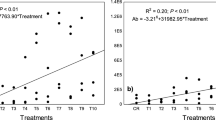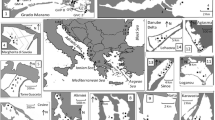Abstract
The ABC method for evaluating pollution-induced stress was tested using data from the Chesapeake Bay, Virginia, collected between 1985 and 1989. Three predictions were tested: (1) benthic communities from estuarine transitional regions with salinities near the range of 5 to 8 parts per thousand (horohalinicium) should be classified highly stressed due to major shifts in ionic composition producing physiological stress; (2) benthic communities from regions subjected to summer low dissolved oxygen conditions (anoxia or hypoxia) should be classified as highly stressed after such events; and (3) benthic communities from sediments contaminated with heavy metals and polynuclear aromatic hydrocarbons should be classified as highly stressed. Only partial support for each of these predictions was found and several problems with the ABC method were obvious. A small number of large-sized species, particularly in mesohaline and polyhaline regions of the estuary, greatly affected the analysis. Similar designations of stress could be produced by simply sampling only for these rare, large species. Regions of the estuary considered a priori as highly stressed were sometimes designated as unstressed due to (1) minor shifts in dominance patterns in benthic communities with low absolute numbers of individuals and biomass, e.g. in regions affected by anoxia/hypoxia, and (2) collection of rare, but large species, such as the tubiculous polychaete, Diopatra cuprea, in contaminated sediments. Regions of the estuary considered a priori as unstressed were sometimes designated as highly stressed due to dense recruitment events. Contrary to assumptions of the ABC method, increased sample size (replication) may result in the collection of rare, large-sized individuals in highly stressed communities. Partial dominance curves were applied to the data and (1) removed the effect of biomass dominants in contaminated sediments changing the classification of communities from unstressed to stressed, (2) did not change the stressed classification due to dense recruitment events, and (3) changed the classification of mesohaline and polyhaline communities from unstressed to stressed, even in the absence of low dissolved oxygen events or contaminated sediments. No single method or analysis is likely to produce stress classifications without unacceptable misclassifications. We propose that ecological stress, from any source, is best measured using multiple methods or analyses with different assumptions. The consistency of classification between different approaches would provide the robustness necessary to judge the reliability of a stress classification.
Similar content being viewed by others
Literature cited
Alden III, R. W., Ewing, R. M., Helmstetter, M. F., Winfield, J. G., Burdige, D. J., Rule, J. H., Wong, G. T. F., Swift, D. J. P., Muller, A. (1991). Distribution and management implications of contaminants in Elizabeth River sediments. Applied Marine Research Laboratory Report No. 741-I, Old Dominion University, Norfolk, Virginia
Austen, M. C., Warwick, R. M., Rosado, M. C. (1989). Meiobenthic and macrobenthic community structure along a putative pollution gradient in southern Portugal. Mar. Pollut. Bull. 20: 398–405
Beukema, J. J. (1988). An evaluation of the ABC-method (abundance/biomass comparison) as applied to macrozoobenthic communities living on tidal flats in the Dutch Wadden Sea. Mar. Biol. 99: 425–433
Bilyard, G. R. (1987). The value of benthic infauna in marine pollution monitoring studies. Mar. Pollut. Bull. 18: 581–585
Boesch, D. F., Rosenberg, R. (1981). Response to stress in marine benthic communities. In: Barrett, G. W., Rosenberg, R. (eds). Stress effects on natural communities. John Wiley, London, p. 179–200
Clarke, K. R. (1990). Comparisons of dominance curves. J. exp. mar. Biol. Ecol. 138: 143–157
Connell, J. H. (1978). Diversity in tropical rain forests and coral reefs. Science, N. Y. 199: 1302–1310
Connor, E. F., McCoy, E. D. (1979). The statistics and biology of the species-area relationship. Am. Nat. 113: 791–833
Dauer, D. M., Ewing, R. M., Ranasinghe, J. A. (1989a). Macrobenthic communities of the lower Chesapeake Bay, Chesapeake Bay Program, March 1985–June 1988. Report to Virginia Water Control Board. Old Dominion University, Norfolk, Virginia
Dauer, D. M., Ewing, R. M., Sourbeer, J. W., Harlan, W. T., Stokes, Jr., T. L. (1982). Nocturnal movements of the macrobenthos of the Lafayette River, Virginia. Int. Revue ges. Hydrobiol. 67: 761–775
Dauer, D. M., Ewing, R. M., Tourtellotte, G. H., Barker, Jr., H. R. (1980). Nocturnal swimming of Scolecolepides viridis (Polychaeta: Spionidae). Estuaries 3: 148–149
Dauer, D. M., Marshall, H. G., Birdsong, R. S., Ewing, R. M., Rodi, A. J. (1989b). Elizabeth River long-term monitoring program: biological monitoring projects. Phase I (February–June 1989). Report to Virginia Water Control Board. Old Dominion University, Norfolk, Virginia
Dauer, D. M., Rodi, Jr., A. J., Ranasinghe, J. A. (1992). Effects of low dissolved oxygen events on the macrobenthos of the lower Chesapeake Bay. Estuaries 15: 384–391
Diaz, R. J. (1989). Pollution and tidal benthic communities of the James River estuary, Virginia. Hydrobiologia 180: 195–211
Environmental Protection Agency (1983). Methods for chemical analysis of water and wastes. EPA600/4-79/020. 3rd edn. March 1983. U.S. Environmental Protection Agency, Environmental Monitoring and Support Laboratory, Cincinnati, Ohio
Environmental Protection Agency (1986). Test methods for evaluating solid waste. EPA/SW-846. 3rd edn. November 1986. U.S. Environmental Protection Agency, Office of Solid Waste and Emergency Response, Washington, D.C.
Gee, J. M., Warwick, R. M., Schanning, M., Berge, J. A., Ambrose, Jr. W.G. (1985). Effects of organic enrichment on meiofaunal abundance and community structure in sublittoral soft sediments. J. exp. mar. Biol. Ecol. 91: 247–262
Gray, J. S. (1979). Pollution induced changes in populations. Phil. Trans. R. Soc. (Ser. B) 286: 545–561
Gray, J. S. (1980). Why do ecological monitoring? Mar. Pollut. Bull. 11: 62–65
Gray, J. S. (1981). Detecting pollution induced changes in communities using the log-normal distribution of individuals among species. Mar. Pollut. Bull. 12: 173–176
Gray, J. S., Ascan, M., Carr, M. R., Clarke, K. R., Green, R. H., Pearson, T. H., Rosenberg, R., Warwick, R. M. (1988). Analysis of community attributes of the benthic macrofauna of Frierfjord/Langesundfjord and in a mesocosm experiment. Mar. Ecol. Prog. Ser. 46: 151–165
Green, R. H. (1979). Sampling design and statistical methods for environmental biologists. John Wiley, New York
Grizzle, R. E. (1984). Pollution indicator species of macrobenthos in a coastal lagoon. Mar. Ecol. Prog. Ser. 18: 191–200
Hall III, L. W., Ziegenfuss, M. C., Fischer, S. A., Alden, III, R. W., Deaver, E., Gooch, J., DeBert-Hastings, N. (1991). A pilot study for ambient toxicity testing in Chesapeake Bay, Vol. I. Chesapeake Bay Program. U.S. Environmental Protection Agency, Annapolis, Maryland
Hartley, J. P. (1982). Methods for monitoring offshore macrobenthos. Mar. Pollut. Bull. 13: 150–154
Holland, A. F. (1985). Long-term variation of macrobenthos in a mesohaline region of Chesapeake Bay. Estuaries 8 (2A): 93–113
Holland, A. F., Shaughnessy, A. T., Hiegel, M. H. (1987). Longterm variation in mesohaline Chesapeake Bay benthos: spatial and temporal patterns. Estuaries 10: 227–245
Huggett, R. J., Bender, M. E., Unger, M. A. (1987). Polynuclear aromatic hydrocarbons in the Elizabeth River, Virginia. In: Dickson, K. L., Maki, A. W., Brungs, W. A. (eds.) Fate and effects of sediment-bound chemicals in aquatic systems. Pergamon Press, New York, p. 327–341
Huston, M. (1979). A general hypothesis of species diversity. Am. Nat. 113: 81–101
Ibanez, F., Dauvin, J. C. (1988). Long-term changes (1977–1987) in a muddy fine sand Abra alba-Melinna palmata community from the Western English Channel: multivariate time-series analysis. Mar. Ecol. Prog. Ser. 49: 65–81
Kinne, O. (1971). Salinity. Animals. Invertebrates. In: Kinne, O. (ed.) Marine ecology. A comprehensive, integrated treatise on life in oceans and coastal waters, Vol. I, Pt. Z. Wiley-Interscience, New York, p. 821–995
Lambshead, P. J. D. (1984). The nematode/copepod ratio. Some anomalous results from the Firth of Clyde. Mar. Pollut. Bull. 15: 256–259
Lambshead, P. J. D., Platt, H. M., Shaw, K. M. (1983). The detection of differences among assemblages of marine benthic species based on an assessment of dominance and diversity. J. nat. Hist. 17: 859–874
Long, E. R., Morgan, L. G. (1990). The potential for biological effects of sediment-sorbed contaminants tested in the National Status and Trends Program. NOAA Technical Memorandum NOS OMA 52. United States Department of Commerce, National Oceanic and Atmospheric Administration, Seattle, Washington
Pearson, T. H., Rosenberg, R. (1978). Macrobenthic succession in relation to organic enrichment and pollution of the marine environment. Oceanogr. mar. Biol. A. Rev. 16: 229–311
Phillips, D. J. H., Segar, D. A. (1986). Use of bio-indicators in monitoring conservative contaminants: programme design imperatives. Mar. Pollut. Bull. 17: 10–17
Raffaelli, D. G., Mason, C. F. (1981), Pollution monitoring with meiofauna, using the ratio of nematodes to copepods. Mar. Pollut. Bull. 12: 158–163
Remane, A., Schlieper, C. (1971). Biology of brackish water. John Wiley & Sons, Inc., New York
Ritz, D. A., Lewis, M. E., Shen, M. (1989). Response to organic enrichment of infaunal macrobenthic communities under salmonid seacages. Mar. Biol. 103: 211–214
Virginia State Water Control Board (1983). The Elizabeth River: an environmental perspective. Basic Data Bulletin No. 61. Virginia State Water Control Board, Richmond, Virginia
Warwick, R. M. (1986). A new method for detecting pollution effects on marine macrobenthic communities. Mar. Biol. 92: 557–562
Warwick, R. M. (1988a). Analysis of community attributes of the macrobenthos of Fierfjord/Langesundfjord at taxonomic levels higher than species. Mar. Ecol. Prog. Ser. 46: 167–170
Warwick, R. M. (1988b). The level of taxonomic discrimination required to detect pollution effects on marine benthic communities. Mar. Pollut. Bull. 19: 259–268
Warwick, R. M., Pearson, R., Ruswahyuni, T. H. (1987). Detection of pollution effects on marine macrobenthos: further evaluation of the species abundance/biomass method. Mar. Biol. 95: 193–200
Warwick, R. M., Platt, H. M., Clarke, K. R., Agard, J., Gobin, J. (1990). Analysis of macrobenthic and meiobenthic community structure in relation to pollution and disturbance in Hamilton Harbor, Bermuda. J. exp. mar. Biol. Ecol. 138: 119–142
Warwick, R. M., Ruswahyuni (1987). Comparative study of the structure of some tropical and temperate marine soft-bottom macrobenthic communities. Mar. Biol. 95: 641–649
Weston, D. P. (1990). Quantitative examiantion of macrobenthic community changes along an organic enrichment gradient. Mar. Ecol. Prog. Ser. 61: 233–244
Author information
Authors and Affiliations
Additional information
Communicated by J.P. Grassle, New Brunswick
Rights and permissions
About this article
Cite this article
Dauer, D.M., Luckenbach, M.W. & Rodi, A.J. Abundance biomass comparison (ABC method): effects of an estuarine gradient, anoxic/hypoxic events and contaminated sediments. Marine Biology 116, 507–518 (1993). https://doi.org/10.1007/BF00350068
Received:
Accepted:
Issue Date:
DOI: https://doi.org/10.1007/BF00350068




